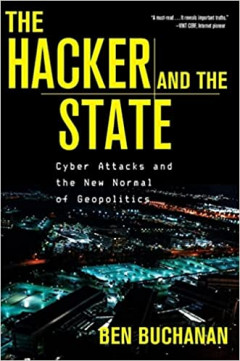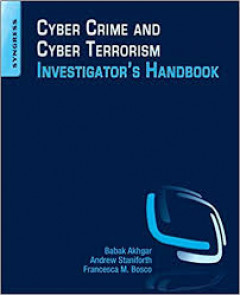Filter by

Manipulated: inside the cyberwar to hijack elections and distort the truth
Table of Contents Prologue Introduction Chapter 1: How Did We Get Here? Chapter 2: Motives & Targets: Manipulation in a Post-Truth, Post-Trust Era Chapter 3: How Do You Know What You Think You Know? Chapter 4: The Manipulators and Their Methods Chapter 5: Hackers in the Trenches Chapter 6: Exclusive Interview: Anatomy of a Manipulation Campaign Chapter 7: The U.S. Elections 2…
- Edition
- -
- ISBN/ISSN
- 9781538133507
- Collation
- xi, 193 hlm.; ilus.; 23,5 cm
- Series Title
- -
- Call Number
- 005.8 PAY m

Blackhatonomics: an inside look at the economics of cybercrime
Blackhatonomics explains the basic economic truths of the underworld of hacking, and why people around the world devote tremendous resources to developing and implementing malware. The book provides an economic view of the evolving business of cybercrime, showing the methods and motivations behind organized cybercrime attacks, and the changing tendencies towards cyber-warfare. Written by an exc…
- Edition
- 1st
- ISBN/ISSN
- 9781597497404
- Collation
- xliv, 216 hlm.; ilus.; 24 cm
- Series Title
- -
- Call Number
- 364.16 GRA b

The hacker and the state: cyber attacks and the new normal of geopolitics
Fundamentally changes the way we think about cyber operations from ‘war’ to something of significant import that is not war―what Buchanan refers to as ‘real geopolitical competition.’” Cyber attacks are less destructive than we thought they would be―but they are more pervasive, and much harder to prevent. With little fanfare and only occasional scrutiny, they target our banks, ou…
- Edition
- -
- ISBN/ISSN
- 9780674987555
- Collation
- 412 hlm; 22 cm
- Series Title
- -
- Call Number
- 005.1092 BUC h

The digital big bang : the hard stuff, the soft stuff, and the future of cybe…
- Edition
- -
- ISBN/ISSN
- 9781119617365
- Collation
- xxviii, 306 hlm.: ilus.; 24 cm
- Series Title
- -
- Call Number
- 005.8 QUA t
- Edition
- -
- ISBN/ISSN
- 9781119617365
- Collation
- xxviii, 306 hlm.: ilus.; 24 cm
- Series Title
- -
- Call Number
- 005.8 QUA t

Cybercrime, cyberterrorism, and cyberwarfare
Terdapat bibliografi dan indeks. Table of contents: 1. Cybercrime, cyberterrorism, and cyberwarfare in perspective 2. Domestic efforts to combat cyberterrorism 3. International efforts to combat cyberterrorism 4. U.S. Policy to prevent a cyber attact 5. Effectiveness of U.S infrastructure programs 6. Critical infrastructure protection program 7. Recommendations on cyber threats and wa…
- Edition
- --
- ISBN/ISSN
- 9781441572172
- Collation
- xi, 263 hal.; ilus.; 23 cm
- Series Title
- --
- Call Number
- 355.4 UDA c

Inside cyber warfare
Terdapat indeks. Table of contents: 1. Assessing the Problem 2. The Rise of the Nonstate Hacker 3. The Legal Status of Cyber Warfare 4. Responding to International Cyber Attacks as Acts of War 5. The Intelligence Component to Cyber Warfare 6. Nonstate Hackers and the Social Web 7. Follow the Money 8. Organized Crime in Cyberspace 9. Investigating Attribution 10. Weaponizing Malware…
- Edition
- Second edition
- ISBN/ISSN
- 9781449310042
- Collation
- xviii, 294 hal.; ilus.; 24 cm
- Series Title
- --
- Call Number
- 363.25 CAR i

Cyber attacks: protecting national infrastructure
Table of Contents Preface Acknowledgments 1. Introduction National Cyber Threats, Vulnerabilities, and Attacks Botnet Threat National Cyber Security Methodology Components Deception Separation Diversity Consistency Depth Discretion Collection Correlation Awareness Response Implementing the Principles Nationally Protecting the Critical National Infrastructure Against Cyber …
- Edition
- 1st edition
- ISBN/ISSN
- 9780123849175
- Collation
- xi, 233 hal.; ilus.; 24 cm
- Series Title
- --
- Call Number
- 363.3 AMO c

Cyber crime and cyber terrorism investigator's handbook
Table of Contents Chapter 1: Cyberspace: The new frontier for policing? Abstract The Shape of the Challenge The Size of the Challenge The Response Conclusion Chapter 2: Definitions of Cyber Terrorism Abstract Introduction The Confusion About Cyber Terrorism Cyber Terrorism Definition Has Cyber Terrorism Ever Occurred? Conclusions …
- Edition
- --
- ISBN/ISSN
- 9780128007433
- Collation
- xxiii, 282 hal.; ilus.; 24 cm
- Series Title
- --
- Call Number
- R363.23 AKH c

Introduction to cyber-warfare: a multidisciplinary approach
Table of Contents Chapter 1. Cyber Warfare: Here and Now What Is Cyber War? Is Cyber War a Credible Threat? Attribution, Deception, and Intelligence Information Assurance I: Cyber Attack Chapter 2. Political Cyber Attack Comes of Age in 2007 Information in this Chapter Reliance on Information as a Vulnerability Rudimentary but Effective: Denial of Service Leaving Unwanted Messa…
- Edition
- 1st edition
- ISBN/ISSN
- 9780124078147
- Collation
- xvii, 318 hal.; ilus.; 24 cm
- Series Title
- --
- Call Number
- 355.4 SHA i

Cyber security and IT infrastructure protection
Contents: 1. Fault tolerance and resilience in cloud computing environments 2. Data encryption 3. Public key infrastructure 4. Physical security essentials 5. Disaster recovery 6. Biometrics 7. Homeland security 8. Cyber warfare 9. System security 10. Securing the infrastructure 11. Access controls 12. Assessments and audits 13. Fundamentals of cryptography 14. Satell…
- Edition
- --
- ISBN/ISSN
- 9780124166813
- Collation
- xxiv, 356 hal.;ilus.; 24 cm
- Series Title
- --
- Call Number
- 005.8 VAC c
 Computer Science, Information & General Works
Computer Science, Information & General Works  Philosophy & Psychology
Philosophy & Psychology  Religion
Religion  Social Sciences
Social Sciences  Language
Language  Pure Science
Pure Science  Applied Sciences
Applied Sciences  Art & Recreation
Art & Recreation  Literature
Literature  History & Geography
History & Geography